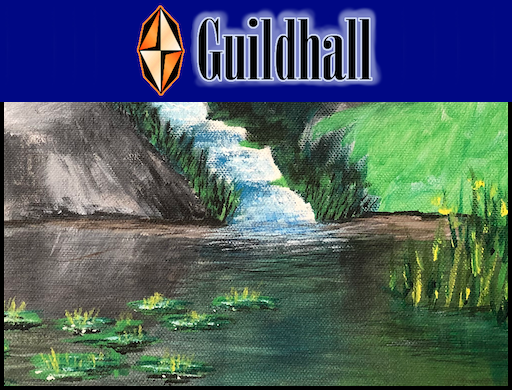




• Seahaven Towers
• Haniport Levee
• Angeline Crossing
• Delvenor Beacon
• Trek
• Dungeon
• Empire

• Terminus
• Grafiker
• Classic
• Contessa

• Paint
• Write
• Acoustiq
• Draw
• Filigree

• Tome
• Gamer
• Orbit
• Atlas
• Chronology

• Editor
• Player
• Reader
• Viewer
• Calc

Paint, the Guildhall image editor

a portion of a painting by Art Cabral, the cover artwork of The Engineer's Field
Paint is Guildhall's image editor, a Works applet. Its design goals are intended to follow the conventions of traditional paint programs but also to include most of the features of PhotoShop as it existed in 1992. To that end it has, as a paint program, a greater emphasis on geometry, being able to draw lines, curves, rectangles, ellipses, round rects, polygons, shapes, and text, but following in PhotoShop's footsteps it also allows selection of soft edges, with feathering and antialiasing and transparency, and convolving tools such as blur, sharpen, burn, and dodge. The one thing it doesn't attempt to do is handle more than a few layers, roughly two or three depending on what tool you're using. The layer constraint is a matter of strong personal preference for me after finding layers always seemed to be getting in the way with post-1992 versions of PhotoShop as well as with modern versions of GIMP (see gimp.org).
Here's a current image with the dropper tool selected.

In the tool palette on the left, the first six tools are devoted to making selections: rectangular, elliptical, by round rect, by polygon, by shape, or by arbitrary region (often depicted as a lasso in other paint programs). The next two tools are for moving. The arrows moves the selection over the image, and the hand moves either the entire selection or, if an image has been pasted into a selection, it moves the image within the selection. Of these tools only the first three are working.
The wand tool does work, and it selects all pixels related to the one under where the wand is clicked, according to tolerance values established for the tool before clicking. Currrently the tolerance values can only be changed with the banner bar, that control strip just below the title bar. Typing a period activates a one line shell program for entering the commands that Paint recognizes. Wand tolerance is a parameter that can be set in this fashion. While there's no reason to remove this capability, the preferred way to change parameters will be to use the tool options field. In the layout above, the dropper tool occupies that area, but it is intended to change as each of the tools is selected. Eventually there will be no hidden parameters. Every tool value will have a UI to modifiy it. But not yet.
On the next row of tools, the pin allows center points of rotation and stretching to be set. The curved arrow represents a rotation tool, either by an implied anchor or about a fixed pin anchor. The dropper, the tool of the moment, allows colors to be picked up from anywhere on the canvas but not (yet) anywhere on the desktop. I'm considering that last feature. I've wanted it on more than one occasion.
The next tool is for cropping, and presumably also for canvas and image resizing, though I haven't worked out the details on that. The magnifying glass is for specific zooming in on particular points (whereas keyboard shortcuts generally control whole zooming).
Next come the painting tools, starting with the text tool and continuing on through lines, polylines, curves, rectangles, ellipses, round rects, polygons, shapes, and regions. More complicated painting tools follow, tools with traditional meanings: the eraser, pencil, brush, gradient fill, spray can, and bucket. Finally come the convolving tools: the blur, sharpen, smudge, burn, sponge, and dodge tools. Of all these, the rectangle, ellipse, round rect, eraser, pencil, brush, and bucket tools are working. The rest are hopefully coming soon.
Next Steps
- Tool option panes for the brush, pencil, eraser, bucket, and wand tools
- Convolving implementation for at least blur and sharpen